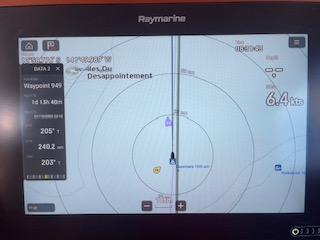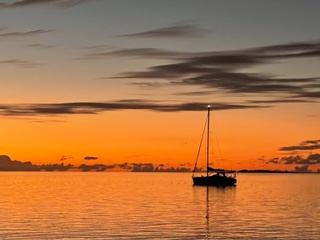The Tuamotus

Casamara
John & Susan Simpson
Thu 1 Jun 2023 23:57
Leaving the towering Marquesas islands behind us we set sail for the Tuamotus, an archipelago of low lying islands each visible from only a few miles away. As with the Marquesas, the 78 islands in the Tuamotus are volcanic but the volcanoes have blown leaving only the ring-shaped atolls at the outer edge and lagoons in the craters. Most atolls have narrow passes through the outer ring giving access to the lagoon in the centre. Entry to and exit from the lagoon must be carefully timed so that the passes are used only at slack water as the tide changes direction. There is so much water flowing in and out of the lagoons that the current can run up to 9 knots through the gap at peak flow. As the average yacht’s top speed under engine is about 6 knots it can be impossible to make headway against the flow or to keep control of steerage if the flow is with the boat. Add to that the possibility of standing waves, swirling whirlpools and cross currents and you will understand that we approached the Tuamotus with a certain amount of trepidation! Sailing in this area must have been treacherous before the arrival of the mechanical engine, satellite navigation and global weather forecasting. However, with the benefit of modern technology we were able to leave Nuku Hiva on Sunday 14th May and manage our speed so that we arrived at the pass into Makemo four days later at exactly low water. The current in the pass was still a bit turbulent but no worse than we’ve experienced in tight channels in the UK, the Needles Channel for example, and we motored through to the lagoon without any issues. We did enjoy seeing the curiously named Îles de Desappointement on our chart along the way, apparently named because there was no fresh water to be found when the islands were discovered.  Makemo covers a surface area of 233 sq miles but the area of land above water is only 22 sq miles, the central lagoon making up the rest. The amount of usable land is even less than this because the circular rim of land is broken in places and not continuous. We took our scooters ashore in the dinghy and set off to explore the ‘town’ of Pouheva (population 600) and the narrow strip of land that constituted the island.  Pouheva dinghy dock with Casamara anchored in the distance Pouheva was a sleepy little place, mostly made up of one storey houses surrounded by colourful gardens. There was a huge church which looked down on its luck, a couple of small general stores and a restaurant that we never managed to find open. A middle school serving the closest islands appeared to have been built quite recently and it’s large cream corrugated iron roofed buildings were prominent on the dockside. As there was little happening in Pouheva the school seemed to dominate the community with constant background noise during the day and early evening of children playing, drumming and singing. The one and only road out of town took us along the atoll rim on a road that was surprisingly well-surfaced and marked out as you’d expect to see in mainland France. Every few hundred metres there was a sign marking the crossing of a boundary between one village and the next, which was strange as there didn’t appear to be houses to go with most of the village names and one would have thought that the local population knew full well where they were without the signs!  Boundary marker - note how the names tend to have duplicated sounds The road to nowhere actually took us to Makemo airport about 10 km from Pouheva. There seemed to have been some recent investment on the island as the airport looked quite new and had a settlement of newly built houses nearby. We loved the optimism of the building of a bus stop outside the airport terminal as there was no bus to be seen on the island and seemingly nowhere for large numbers of people to stay; there were cars and 4x4s but the most frequent mode of transport was the tricycle.  Makemo Airport terminal building and bus stop If Makemo seemed remote and isolated then our next atoll was even more so. Tahanea covers 201 sq miles but only 3.7 sq miles is above sea level. The island is uninhabited and it’s village abandoned, although a couple of fishermen from a neighbouring island appeared to be camping on the beach. They approached one lunchtime to offer us a large freshly-caught Tuna. All they wanted in return was either two cigarette lighters or some whisky but we had none of the former and didn’t want to part with any of the latter! The provision of alcohol to the local people is in any case strongly discouraged and we’d been told not to trade it if asked. Tahanea was John’s dream wingfoiling destination - a large area of flat sea with plenty of wind. We met up with one of the guys from another ARC Pacific rally boat and an Australian couple wingfoiling from their boat, Silver Chief, for a day of trying out each other’s equipment and swapping tips.  Preparing to wing foil The water in both atolls was beautifully clear, so much so that we could see fish and corals without leaving the boat. The coral bommies on the sea bed made for interesting anchoring as the anchor chain could easily wrap itself around them. Not only would this make it difficult to raise the anchor but we might also damage the coral in the process. We tried out a new (to us) technique of floating the chain by tying a fender part way between the anchor on the sea bed and Casamara. We were sceptical about the success of this as the chain lying on the sea bed is important for keeping the anchor bedded in. However, the technique worked and our anchor chain hovered just above the coral without issue.  Silver Chief against the sunset in Tahanea After Tahanea we had intended to visit one more atoll before leaving these remote islands but a routine check on Casamara’s rigging showed some cracking to one of the shrouds. The weather forecast was ideal for the 48 hour sail to the commercial centre of French Polynesia, Papeete in Tahiti, so we decided the prudent thing would be to head straight there for repairs. We left through the pass on the afternoon tide and left the remoteness and tranquility of Tahanea behind us. Next stop the bright lights of Papeete! |